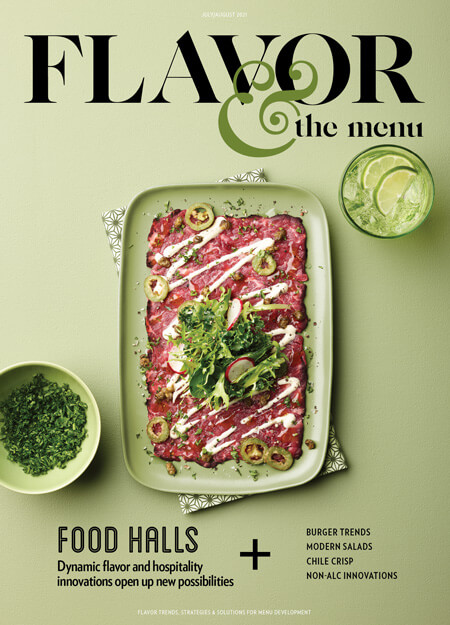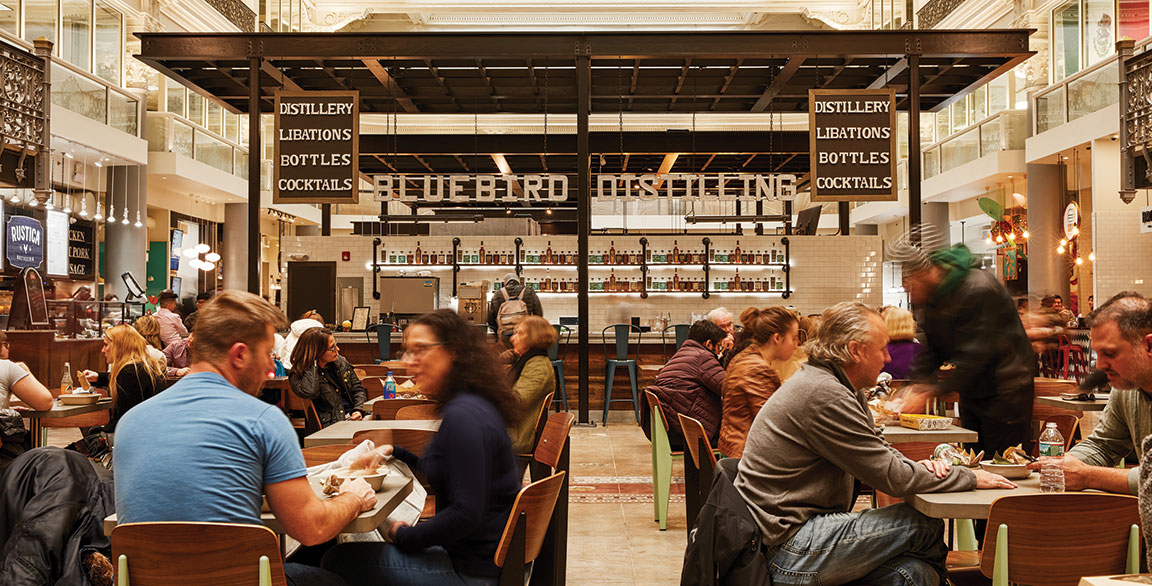

Today’s food halls are lively social hubs, marked by a collection of niche restaurant concepts that draw people in with the promise of something special. They’re entertaining, immersive and experiential. Food halls bustle. They invite discovery, foster local talent and celebrate food cultures.
Modern food halls are sprouting up across the country, influencing the way Americans dine out. Although each boasts a distinct personality, purposefully carving out a unique presence that reflects pride of place, they all share an approach to menu concepts and customer experience that offers valuable insights to menu developers in all foodservice segments.
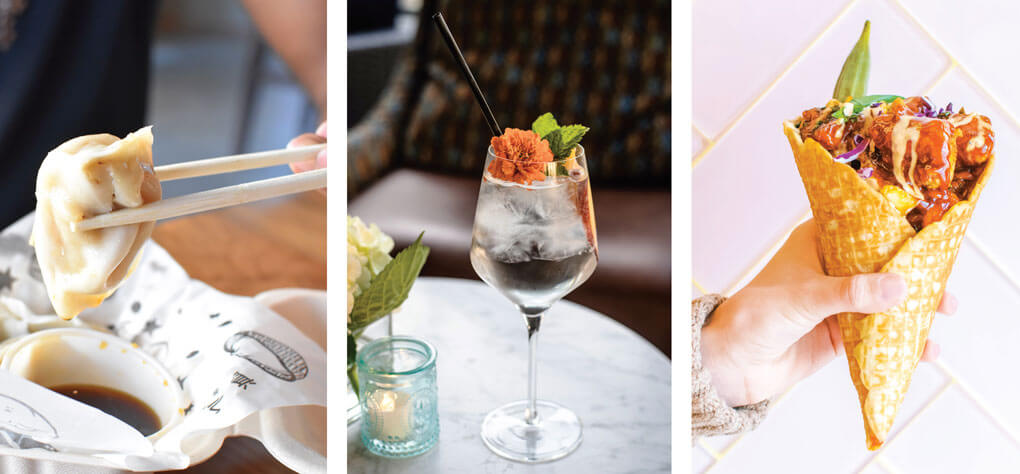 Photo credits (l-r): Steam Boys, Tonic Bar, Buttercup
Photo credits (l-r): Steam Boys, Tonic Bar, Buttercup Thanks in part to their transparent, customer-facing setup, modern food halls can fast-track trends in both flavors and formats. Trend-forward examples include Steam Boys’ dumplings at Assembly Hall in Nashville, Insta-ready fare at Legacy Hall in Dallas with a Summer Spritz from Tonic Bar and a Nashville Waffle Cone from chicken tenders concept Buttercup.
A quick look across the country reveals how food halls today have become a hotbed of specialty cuisines, fertile ground for incubating trends—and often nurturing concepts before launching them into brick-and-mortar locations. At Inner Rail Food Hall, located in the heart of Omaha, Neb., diners can try authentic Nepali street food at Kathmandu Momo Station. Offerings include hand-wrapped chicken, pork or vegan dumplings called momos, served with either a sesame-tomato-Nepal pepper sauce or a sauce made with peanuts, soy and tomatoes.
The Bourse, a Philadelphia food hall housed in a restored building that was the nation’s first commodities exchange market, gives visitors a taste of Taiwanese fried chicken, served at the eclectic slider concept, Baby Buns.
At Assembly Hall in Nashville, Hawaiian shave ice shop Cotton & Snow introduces new flavor experiences while keeping fun front and center. Its boozy Whisk Me Sour stars tart lemon juice-flavored “snow” mixed with whiskey and topped with a cherry, while the non-alc SnoFrapp features a locally roasted cold-brew coffee flavor with whipped cream, chocolate and caramel sauce.
A great food hall experience is about discovery. You get hit with textures, sounds and smells that immerse you in the moment.
Michael Morris, Principal, CANAdev
With food halls playing a larger role in the food scenes of cities and towns across America, it stands to reason that they are helping both accelerate and broaden the familiarity of emerging world cuisines, global mash-ups and new flavor trends, kicking the adoption cycle into higher gear.
That broadening of familiarity stems from market placement—these food halls with Nepalese or Taiwanese influences aren’t limited to America’s most-recognized foodie hubs like Chicago, New York and Los Angeles. They’re found in Omaha, Minneapolis and Knoxville, metropolitan areas recently emerging as destinations for global cuisines.
Food halls are democratizing food trends, filtering them through the micro cultures of local food scenes across the country, creating a network of dynamic and exciting food and beverage concepts.
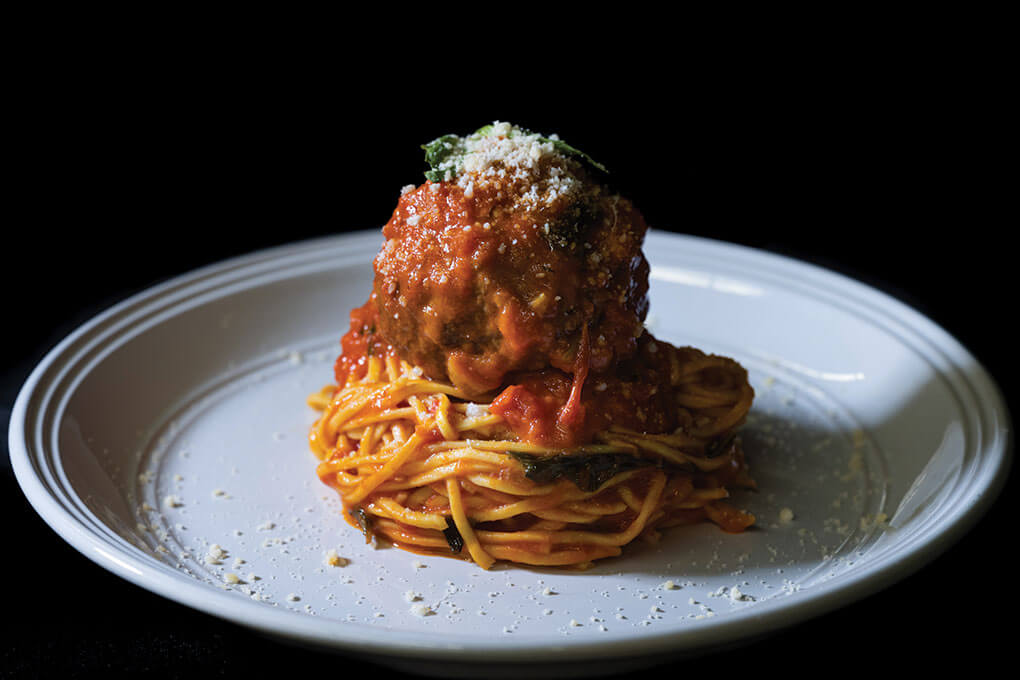 Photo credit: Joey Meatballs / The Hall at Malcolm Yards
Photo credit: Joey Meatballs / The Hall at Malcolm Yards Malcolm Yards Market in Minneapolis balances out more adventurous fare with comfort favorites—still with an eye on quality and authenticity. Joey Meatballs partners with local farmers and offers scratch-made build-your own pasta bowls.
An All-Day Affair
Consumers can dip in and out of cultures at a food hall, sampling adventure or indulging in the familiar, strolling through an experience that they curate for themselves. “A great food hall experience is about discovery. You get hit with textures, sounds and smells that immerse you in the moment,” says Michael Morris, principal at Baltimore-based CANAdev, a food hall development and management company behind The Bourse, which opened in 2018.
That immersive experience is what distinguishes today’s modern food halls. They engage guests holistically and for longer periods of time with a creative variety of themed entertainment, provided through a combination of food, beverage, music, games, social spaces and more.
Jack Gibbons is CEO of FB Society, a Dallas-based restaurant group that includes 10 restaurant brands and two food halls: Legacy Hall in Plano, Texas, and Assembly Hall in Nashville. He recognized the spark of opportunity back in 2015, after visiting a food hall in Amsterdam.
“What we saw was really fascinating: The ownership of that new food hall ran the bars. In contrast, the few U.S. food halls that were in operation back then were treated like real estate investments, and everything was divided up. There was really no alcohol or beverage component to them. That was our big idea—come back to the U.S. and create a restaurateurs’ food hall, where you have a unique group of entrepreneur chefs who can start and run their own businesses.”
When Gibbons and his team studied the market, they also saw a need to provide entertainment. “We didn’t see music associated with food halls,” he says. “That’s really huge. Entertainment is driving more people to come and experience food halls all day. It isn’t just a lunch place. You can come, you can leave, you can use it all day. The idea of creating larger experiences for consumers was super exciting to us.”
A thread that runs through modern food halls is the sense of local community. It is steeped into the historic buildings that are revamped and restored as hosts. It’s told through the local retailers that participate, from boutique spice houses and skilled artisans to the food vendors drawn from a pool of mostly local culinary talent.
“The driving force of our food halls is that you’re in the middle of what’s happening,” says Gibbons.
At Nashville’s Assembly Hall, the famous Prince’s Hot Chicken stands as ambassador for iconic area dishes, but Istanbul Shawarma also represents the food culture of Music City. “The largest Kurdish population in the U.S. is right outside of Nashville,” he says. “Our head of curation studies an area, and we find what best represents the community and keeps the food hall mix exciting. In a restaurant with a traditional menu, you can take a risk on a few individual items. But in a food hall, you can take a risk on a few concepts.” Those risks are worth it because they contribute to the overall experience of exploration and discovery.
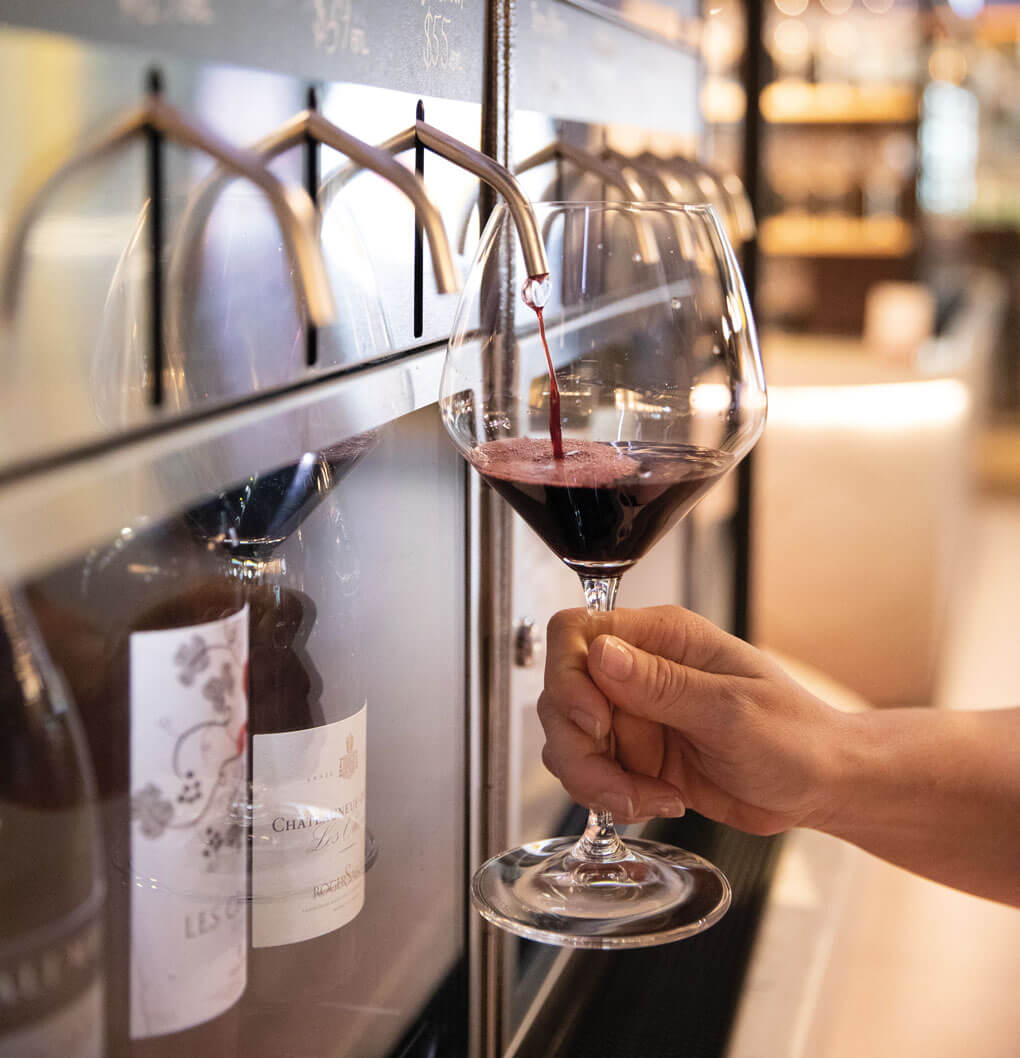 Photo credit: Plano Magazine
Photo credit: Plano Magazine At Legacy Hall in Plano, Texas, the newly-opened Vinotopia wine retail shop and tasting bar is the answer to increased consumer demand for sampling.
A smart strategy that helps mitigate risk is the “edutainment” approach, on full display at the soon-to-open Famous Foods Street Eats at Resorts World in Las Vegas. Inspired by food hawkers in Singapore, 16 stalls will serve up reimagined fare. Videos and info boards at each stall aim to entertain, educate and enrich, sharing information about the vendor, the recipes and the cultural significance of the offerings. This clever tactic signals the success found in modern approaches to persuading consumers to venture out of their comfort zone and explore the unknown.
Famous Foods will host a bevy of trend-forward concepts: Tiger Sugar, a Taiwanese bubble tea shop, will offer cold black tea drinks like Black Sugar Boba Milk. Blood Bros. BBQ, the Houston barbecue joint, will serve its specialty, but with Chinese and Vietnamese flavor touches. And Kuru Kuru Pa Yakitori, a Japanese and anime-inspired concept will menu yakitori, kushiyaki and yaki onigiri, as well as signature drinks and mochi.
When you open in a food hall, it’s a nontraditional space that gives pliability
to your menu. You get to experiment, which is what great R&D is about.
Jack Gibbons, CEO, FB Society
Gibbons says one of the most exciting elements of modern food halls right now is sampling, something that easily translates to brick-and-mortar restaurants. “Sampling is a big idea worth exploring. It’s very engaging,” he says. While in most bars, customers request specific drinks and brands, Gibbons sees that changing. “I think there’s a younger audience who wants to taste and compare.” He answers that demand with the newly opened Vinotopia, a wine retail shop and tasting bar at Legacy Hall.
That interactive model is tracking in other food halls, too. At newly opened The Market at Malcolm Yards in Minneapolis, visitors can help themselves to a display of beers, ciders, wines or kombuchas at a self-pour “tap wall.” “The food hall is an energetic, interactive space, and this kind of unique, fun experience is a big part of that,” says Patricia Wall, co-owner. Beer ambassadors stand at either side of the wall, not only helping guests to navigate the sea of choices, but also providing guidance on using the reloadable RFID “Yard Card” that serves as currency in the food hall.
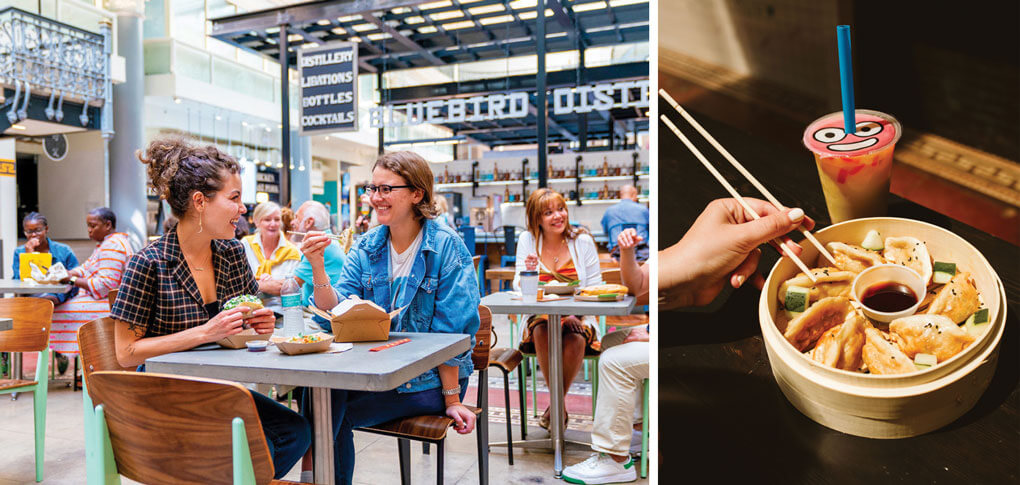 Photo credits (l-r): Visit Philadelphia, Punch Media
Photo credits (l-r): Visit Philadelphia, Punch Media At Philadelphia’s The Bourse, the food hall experience is in full force, offering a range of fun stalls like the globally inspired Pinch Dumplings.
A Story of Flavor Diversity
Certainly one of the biggest draws for consumers is the low-risk commitment of expanding flavor horizons while pleasing everyone in the group with a range of choices: At The Bourse, a family can divide and conquer: Lamb with leek dumplings from Pinch Dumplings for Mom; an artisan grilled cheese featuring local cheesemakers from Mighty Melt for Dad; and Roman-style pizza from Bricco Pizza Romana for the kids.
With the pandemic forcing many chefs out of restaurant jobs—along with many who simply seek new ventures—food halls have become a beacon for culinary talent. It makes dollars and sense because food halls offer a lower barrier of entry to both opening up and maintaining new concepts. Start-up costs and operating budgets are much lower, given the smaller footprint and the supportive partnership with the food hall owner. “We take care of things like POS, waitstaff, the dish pit, front of house and so on,” says Wall. “We take a percentage of sales, but it’s a percentage that allows the vendors to be very successful.”
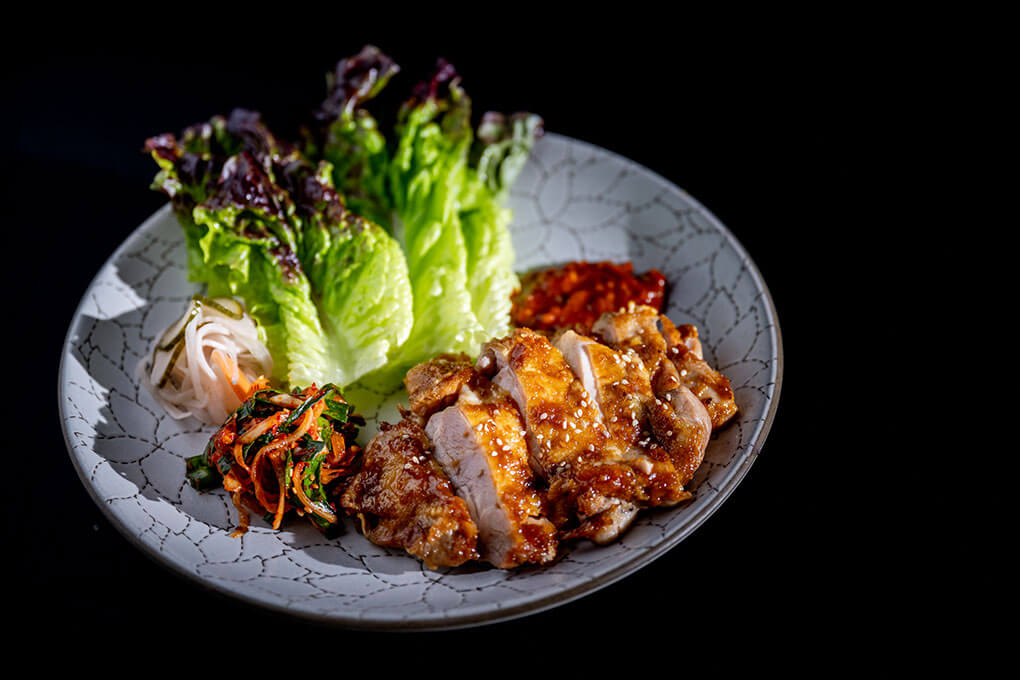 Photo credit: Abang Yoli / The Market at Malcolm Yards
Photo credit: Abang Yoli / The Market at Malcolm Yards Abang Yoli, a Southeast and East Asian kitchen in Minneapolis’ Malcolm Yards, is one of nine vendors strategically chosen to deliver familiarity and intrigue, such as this Chicken Ssam with spicy gochujang.
Making food halls attractive to local talent is a savvy strategy to ensure the mix of food and beverage options is distinctive in the community. Malcolm Yards has an opening roster of nine vendors strategically chosen to bring a mix of familiarity and intrigue to market.
Abang Yoli serves as a good example. A Southeast and East Asian kitchen, it’s owned and operated by Jamie Yoo, who worked under Gavin Kaysen at Bellecour, but lost his job when the restaurant shuttered in the wake of COVID. With his food hall concept, Yoo explores what he describes as “a meaningful example of contemporary Asian cuisine.” Menu items include Chicken Ssam with spicy gochujang and a sesame-ginger-garlic chargrilled leg and thigh, pickled vegetable, garlic-chive kimchi and artisan lettuce.
I love and hate food halls. What I hate is you have to split up to get your food. We wondered why we couldn’t do what restaurants do and use technology to synchronize orders.
Max Trujillo, Co-Founder and Director of Operations, Craften
“Food halls give chefs an opportunity to launch themselves into something different,” says Wall, citing another incentive that draws talent. “They can experiment and do it with a lot less risk.” And the experimentation on display in these niche restaurants is driving emerging trends. Craftsmanship, authenticity, flavor diversity and connection are qualities of food hall experiences that are resonating with today’s consumers. “A connection to the creators is such an integral piece,” says CANAdev’s Morris. “There’s a place for frictionless purchases and ghost kitchens, but food halls are about connectivity.”
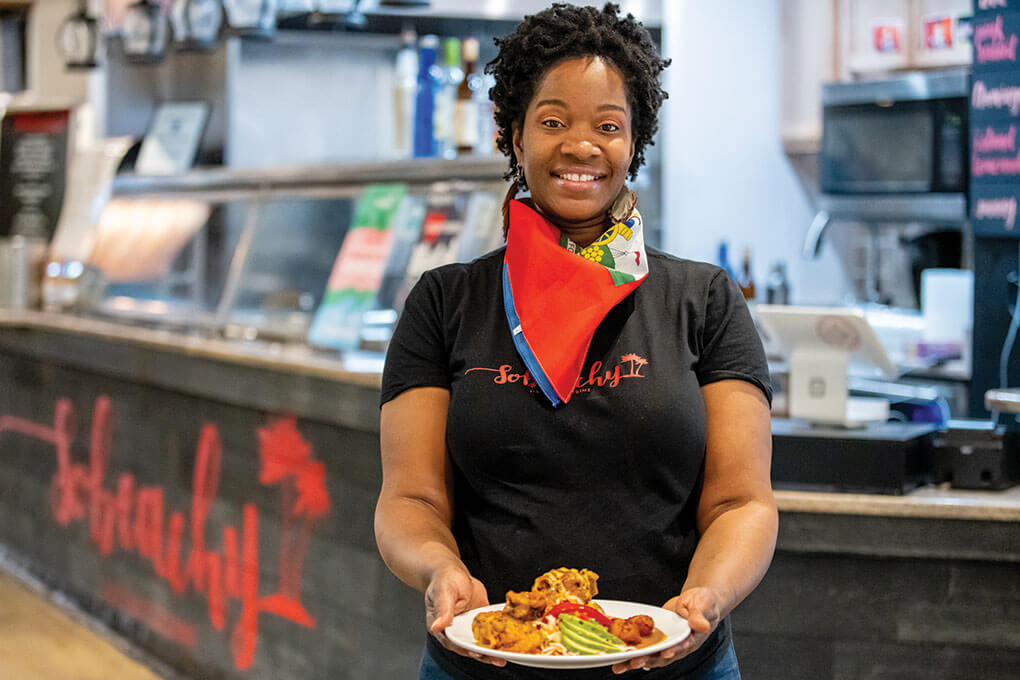 Photo credit: Cana Development
Photo credit: Cana Development Chanel Fleurimond, co-owner of Sobeachy Haitian Cuisine at Baltimore’s Cross Street Market, steps out from behind the counter and engages with her customers, answering questions and offering samples. That tactic has proven successful, encouraging discovery and building a sense of community.
Morris points to two food hall vendors at Cross Street Market in Baltimore, who took different approaches in how they interacted with guests, with decidedly mixed results. “An Egyptian concept, which was promising because there’s been a really strong push in the Middle Eastern category, made fatal errors,” he says. “It only offered digital ordering, eliminating the opportunity to ask questions and engage.” The concept didn’t survive very long.
On the flip side, a vendor that features Haitian food—another unfamiliar cuisine to many Americans—has done incredibly well. Morris credits much of its success to its commitment to customer interaction. “You can’t walk by Sobeachy’s stall without someone interacting with you. They engage; they give samples. They add the human element and social connection,” says Morris. Guests of the food hall walk away with an understanding—and perhaps even a hankering—for the Haitian flavors experienced at Sobeachy. Pikliz, the island’s signature condiment of pickled cabbage, carrots, bell pepper and Scotch bonnet peppers, could conceivably gain greater traction on foodservice menus thanks to exposure in food hall concepts like this one.
Through Son of a Butcher, we found out that we were attracting a different customer than your typical burger consumer. That interaction at a food hall is so intense, it gives menu developers an opportunity to learn so much more about guests, revealing ideas on how you can grow your brands.
Jack Gibbons, CEO, FB Society
Argentinian street food is another example of a cuisine primed to pick up momentum, propelled by narrow-focused vendors zeroing in on a few of its translatable dishes. At Malcolm Yards, Del Sur Empanadas offers a variety of handmade empanadas, from the traditional Sweet Beef with raisins, onions, eggs and green olives to the eclectic Sweet Corn with scallions and red pepper.
In St. Louis, soon-to-open City Foundry Food Hall will house Buenos Aires Café, giving the choripán, a craveable Argentinian pork sausage link, a broader audience. Here, it will be served as a sandwich, first marinated in chimichurri, then drizzled with the restaurant’s signature chimichurri-based sauce and served with fries.
For operators, food halls offer a favorable risk/reward ratio in going to market with these emerging cuisines. For consumers, the ambiance of a food hall invites trial, so the exploration of new flavors is stress-free. For menu developers across the industry, this dynamic segment provides a peak around the corner at emerging trends. It sheds light on shifting consumer preferences, and it can also serve as a proving ground for new ideas.
“Legacy Hall has become a place where I incubate brands and play with them before trying them outside the hall,” says Gibbons. “I’ve talked to a few big restaurant companies about creating a brand in the food hall because it’s so much less expensive than launching a brick-and-mortar. It’s also under less scrutiny. When you open in a food hall, it’s a nontraditional space that gives pliability to your menu. You get to experiment, which is what great R&D is about, rather than doing it within the four walls that people are already familiar with.”
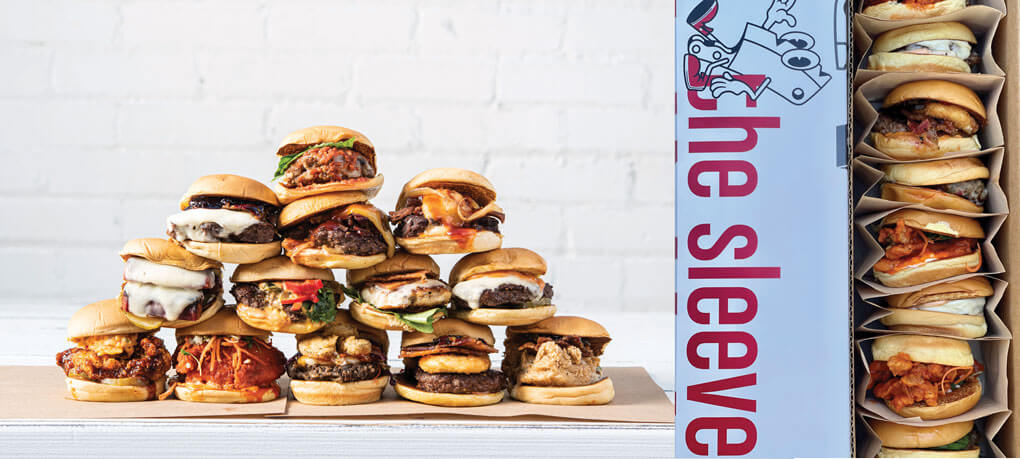 Photo credit: Son of a Butcher
Photo credit: Son of a Butcher Son of a Butcher, the slider concept that started life as a stall in Legacy Hall, has expanded into a brick-and-mortar location in Dallas, adding on fried chicken options to its menu. Guests can go with wildly different flavor builds, including its proven beef sliders: the Classic, topped with “SOB” sauce, American cheese and pickles; and The Popper, with fried jalapeño and cream cheese, pepper jam, bacon and chipotle mayo. Fried chicken sliders include the Sticky Chick with Fresno chile, basil, green onion, peanut, lettuce, mayo, sesame seeds and sticky sauce. Guests at both locations can order “The Sleeve,” (far right) a butcher’s dozen of 13 mix-and-match sliders, hosted in eye-catching packaging that has given the brand great traction on social media.
Gibbons and his team at FB Society incubated a nostalgic sliders concept called Son of a Butcher, launching it from a stall in Legacy Hall in early 2020. “When we created the burger concept, we wanted something that was relevant for my teenager, who prefers smaller portions with unique flavors and then will order three or four of them,” says Gibbons. “Through Son of a Butcher, we found out that we were attracting a different customer than your typical burger consumer.” The brand has been hugely successful, growing into a brick-and-mortar location last December, with plans for national expansion.
Guests can select from builds that star locally raised, organic Wagyu beef patties, ranging from The Popper, with fried jalapeño and cream cheese, pepper jam, bacon and chipotle mayo to the TX Philly, topped with poblano peppers, caramelized onions, nacho cheese, Fresno chile, cilantro and chipotle mayo. Guests can order 1, 2 or 3 sliders, or a “butcher’s dozen,” served in a long, narrow, boxed “sleeve.”
A connection to the creators is such an integral piece. There’s a place for frictionless purchases and ghost kitchens, but food halls are about connectivity.
Michael Morris, Principal, CANAdev
“Someone picked up a box of them and posted a review on TikTok,” says Gibbons. “This individual’s reviews normally average 20,000 views. This one got 2.3 million. The lines were out the door.” Food halls are prime locations to study how to engage with new guests and observe how they are experiencing food and beverage, particularly Millennials and Gen Z.
“That’s where I think the larger restaurant brands might be missing an opportunity to experiment with how they’re interfacing with younger guests, how they’re packaging their food and finding out what exciting things can be a stretch for their brands,” says Gibbons. “That interaction at a food hall is so intense, it gives menu developers an opportunity to learn so much more about guests, revealing ideas on how you can grow your brands.”
Of course, food halls also make a very comfortable home for old-time favorites, as long as the quality is high and the connection to the makers is evident. Malcolm Yards features Detroit-style pizza from Wrecktangle Pizza, offering menu choices like Peter Is a Phreaking Jerk, pizza topped with jerk roast beef and pineapple salsa.
And The Bourse in Philadelphia is practically compelled to carry the iconic Philly cheesesteak for locals and tourists alike. Marino Bros. Cheesesteaks serves up sandwiches with ribeye and a choice of American, ‘whiz or provolone cheese “wit’ or wit’out” onions. It also menus spin-offs, including a Buffalo Chicken Cheesesteak with hot sauce and blue cheese.
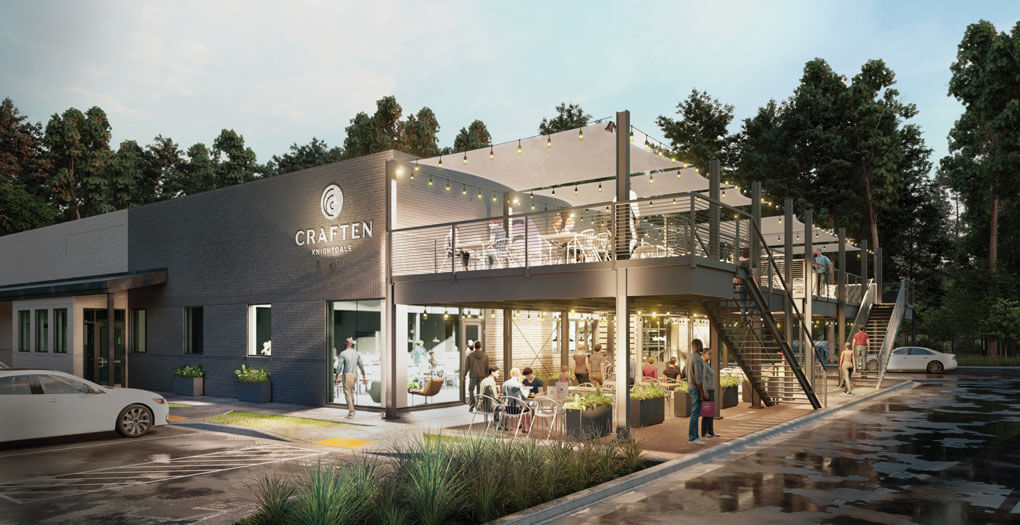 Photo credit: Craften
Photo credit: Craften Craften, a hybrid-model food hall coming soon to the Raleigh, N.C., suburbs, showcases a boutique feel and elevated hospitality through table service.
User Experience
Although many food halls offer consumers the same model of service—communal spaces with walk-up stalls and/or kiosks for placing orders—a few new halls are introducing different service approaches.
Recently opened, high-end Rosetta Hall in Boulder, Colo., feels more like a gathering place than a food hall, says CEO Donovan Greene. It features eight restaurant concepts, two bars and a weekend dance club. The vibe is different, replete with inviting seating areas made of plush couches and chairs; bars on two levels; and an expansive rooftop patio that sets the mood with a happy hour oyster bar, luxe cabanas and fire pits.
Food halls give chefs an opportunity to launch themselves into something different. They can experiment and do it with a lot less risk.
Patricia Wall, Co-Owner, The Market at Malcolm Yards
Another noticeable difference in approach to mood and service is the full-service remote ordering system available at some food halls, which allows visitors to order from any stall without leaving their social circle to queue up and wait.
Craften, a boutique food hall opening in fall in Knightdale, a suburb east of Raleigh, N.C., is rolling out a leading-edge service model. “We’ll have the variety of a food hall with the hospitality of a restaurant,” says Max Trujillo, co-founder and director of operations.
“I love and hate food halls. What I hate is that you all have to split up to get your food. That’s challenging with kids and can be impractical if you want to take your staff out to lunch, or something like that—but still, I go because there are so many great things about food halls, particularly the opportunity to experience different types of food. We wondered why we couldn’t do what restaurants do and use technology to synchronize orders.”
From their tables, customers will be able to order everything online or from a server. The order will go to a centralized POS system employing a technology dubbed as “throttling” to ensure that while each vendor receives the table’s order at the same time, items are prepped in such a way that they are all ready and served simultaneously. “You strategically time how long it takes to make each item from each vendor, then figure out the average time and program that into the system,” explains Trujillo.
Craften will feature an eclectic mix of vendors, including The Corner Venezuelan, Poblanos Tacos and Fiori Trattoria, as well as the Craften Bar, which Trujillo describes as “Craften’s revenue generator.” “We’re doing a much more concerted effort in the beverage program, thinking it will be key to success in the suburbs,” says Trujillo. Next year, he plans on opening a larger location in Clayton, N.C., another Raleigh suburb.
Food halls today offer immersive, entertaining community experiences with destination dining venues. They stand at the intersection of classic hospitality and forward-leaning engagement. “How do you create wonder, interaction and curiosity, and get people to say that this is something different?” asks Gibbons. “That’s the question that we’re trying to answer. We learn as we go. We’re building muscle, stretching it. That’s where food halls can be so exciting for menu developers. There’s not a lot to lose—it’s a good way to stretch.”
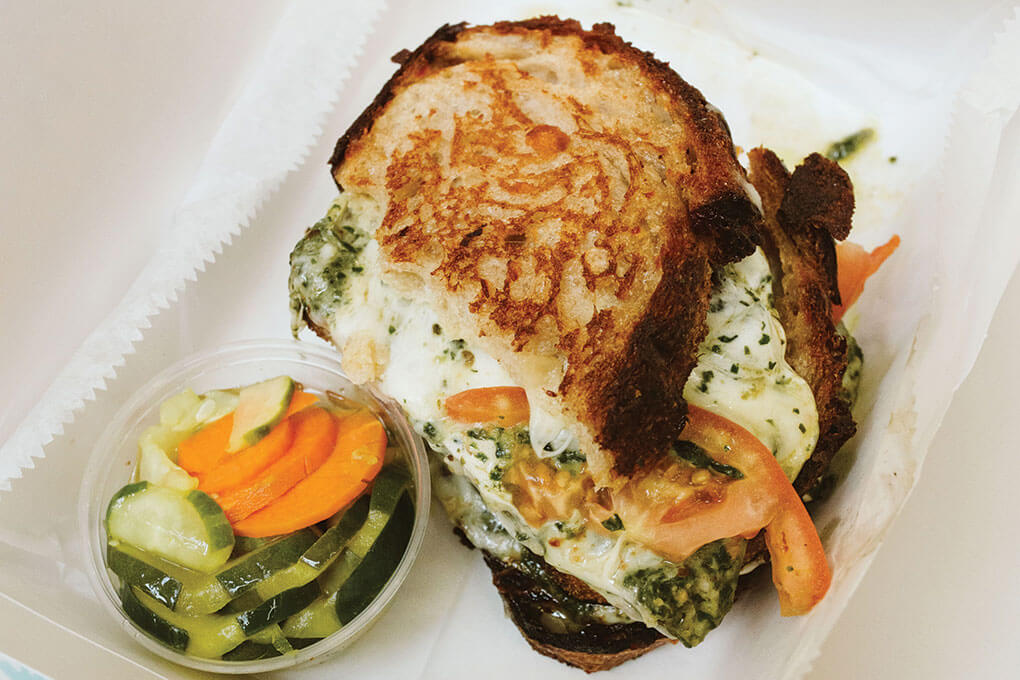 Photo credit: Punch Media
Photo credit: Punch Media The Mighty Melt’s comfort-centric grilled cheese sandwiches showcase the products of local cheesemakers for a regional tie-in at The Bourse food hall.
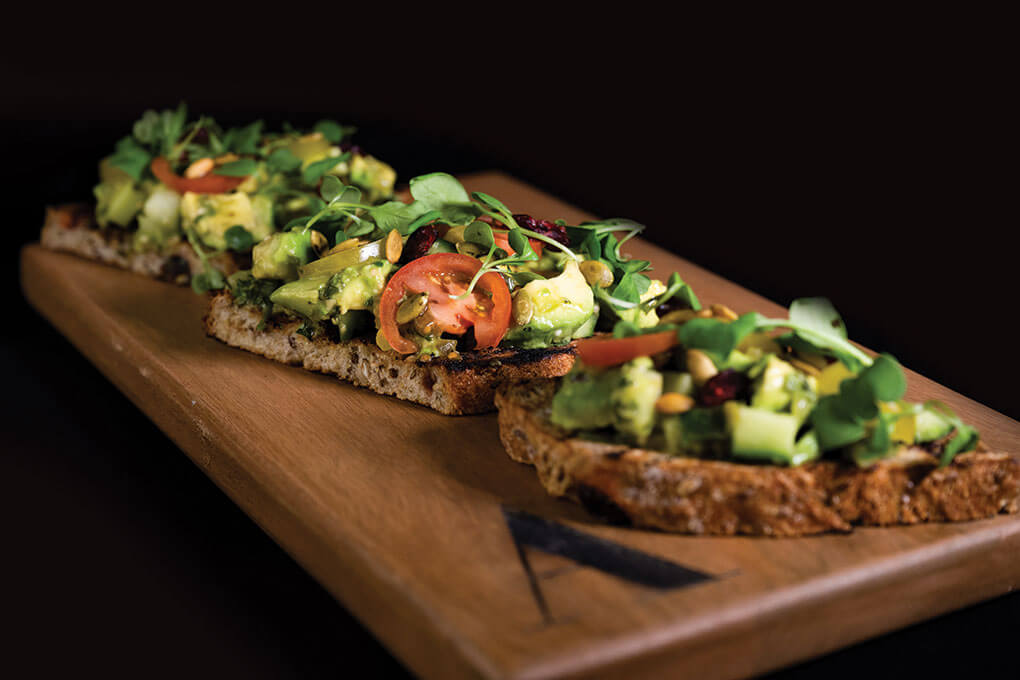 Photo credit: Advellum / The Market at Malcolm Yards
Photo credit: Advellum / The Market at Malcolm Yards Michael Shaughnessy, executive chef/owner of Advellum, the “vegetable eatery” at Malcolm Yards in Minneapolis, menus a creative take on avocado toast topped with cucumbers, baby tomatoes, radish, lime, arugula, pepitas and charred tomatillo vinaigrette on grilled cranberry wheat.
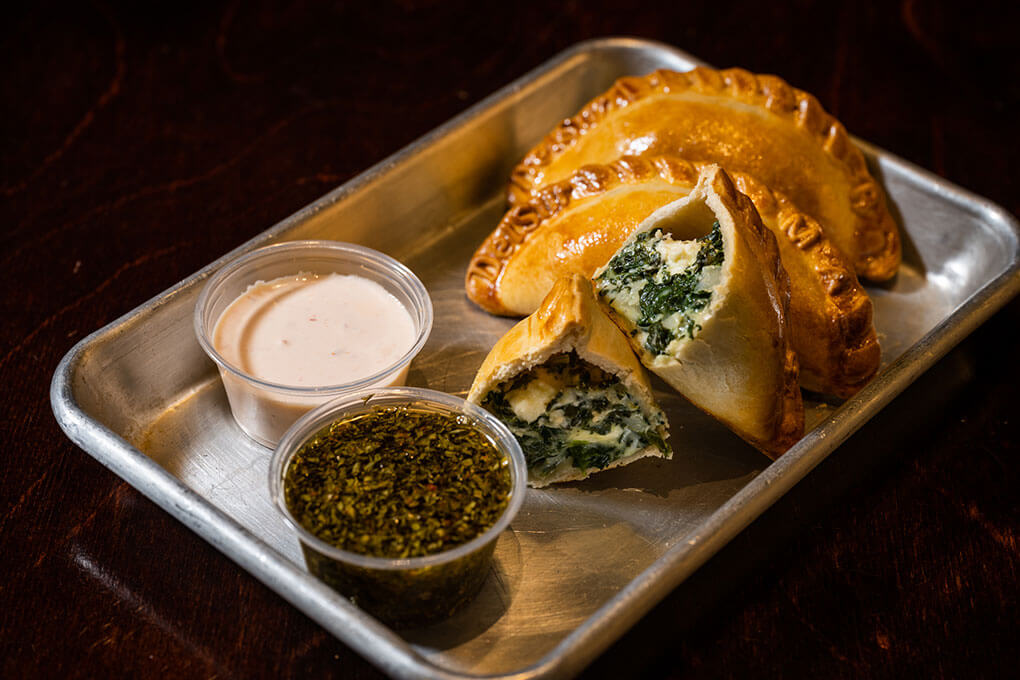 Photo credit: DelSur Empanadas / The Market at Malcolm Yards
Photo credit: DelSur Empanadas / The Market at Malcolm Yards Argentinian street food is poised to break through, thanks in part to the narrow focus of food halls serving up easily translatable dishes like these handmade empanadas from DelSur Empanadas at Malcolm Yards in Minneapolis.







